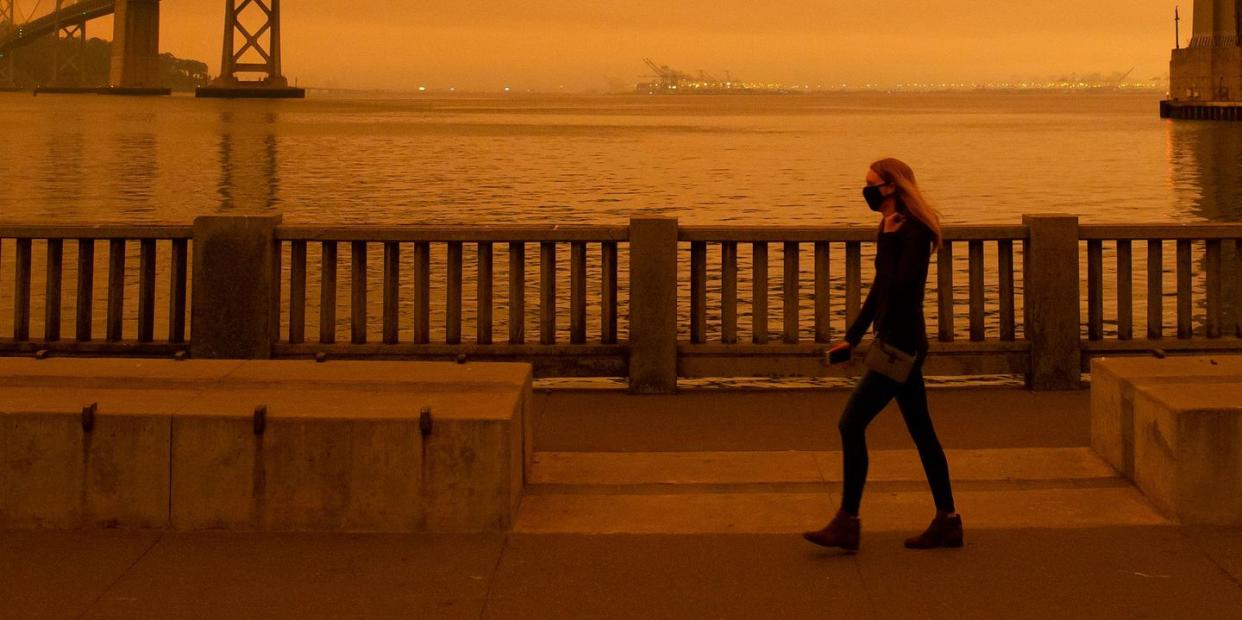Can a Face Mask Protect You Against Wildfire Smoke? Here’s What Doctors Want You to Know

Historic wildfires continue to burn in California, Washington, and Oregon, blanketing the West Coast in heavy smoke and orange skies. According to AirNow, a government agency-run organization, many regions currently have “very unhealthy” or “hazardous” air quality.
Public health officials and doctors have made it very clear that breathing in wildfire smoke is bad for your health. So, can a face mask help protect you? Here’s what you should know.
First, what are the health effects of wildfire smoke?
Wildfire smoke is a mixture of gases and fine particles from burning vegetation, parts of buildings, and other materials, according to the Centers for Disease Control and Prevention (CDC). Breathing in this smoke can cause these immediate health issues, per the CDC:
Coughing
Trouble breathing normally
Stinging eyes
A scratchy throat
Runny nose
Irritated sinuses
Wheezing and shortness of breath
Chest pain
Headaches
An asthma attack
Tiredness
Fast heartbeat
What’s more, experts say prolonged exposure to wildfire smoke can eventually inflame your lungs, potentially leading to thickening or scarring. The fine particles can also worsen the symptoms of chronic heart and lung diseases, and make you more susceptible to lung infections, including COVID-19, according to the CDC.
What are the best face masks for wildfire smoke?
An N95 mask “will offer some protection,” when it’s worn properly, the CDC says. N95 masks filter out up to 95% of airborne particles, including the microscopic ones in wildfire smoke, which are known to travel deeply into the lungs. However, we are still in the middle of the COVID-19 pandemic, and N95 masks still may be in short supply as frontline healthcare workers use them while treating patients.
“Unfortunately, there is no completely safe mask unless you go to a self-contained respirator, which some firefighters are using,” says Raymond Casciari, M.D., a pulmonologist at St. Joseph Hospital in Orange, Calif. “But they’re extremely hot, extremely heavy, and not the kind of thing you can wear for eight hours a day.”
Dr. Casciari says you could try a KN95 mask, which is China’s version of the N95—just know that they don’t meet the same standards as an N95. Jonathan Parsons, M.D., a pulmonologist at The Ohio State University Wexner Medical Center, agrees. “There are some very subtle differences, but essentially they are equivalent in terms of protection from smoke exposure,” he says.
That said, make sure you are purchasing your mask from a trusted retailer. “A lot of KN95s have been reported as counterfeit, so they do not provide the protection for which they indicate,” says Mitchel Rosen, Ph.D., an associate professor at the Rutgers School of Public Health. (Check out these tips from the CDC on how to spot a counterfeit mask.)
If you happen to have an N95 mask, Dr. Parsons says it is OK to use it in this case due to the public health risk of the wildfires, even though it’s largely recommended that they be reserved for frontline workers and emergency responders.
The CDC warns that cloth face masks “offer little protection” against wildfire smoke and “they do not catch small, harmful particles in smoke that can harm your health.” But Dr. Casciari adds that cloth masks “still filter out the ash and bigger particles,” and “there’s something to be said for that.” Plus, you should be wearing one anyway if you are out and about and cannot maintain a six-foot distance from others.
Other ways to protect yourself against wildfire smoke
Beyond wearing a face mask when necessary, you can potentially lower your exposure to wildfire smoke with a few extra precautions. The CDC specifically recommends the following:
Stay indoors, and keep your windows and doors closed.
Limit outdoor exercise when it’s smoky, or choose lower-intensity activities to reduce your exposure to smoke. (“When you exercise, you’re breathing in large quantities of air and bringing it into deeper parts of the lungs,” Dr. Casciari says.)
Avoid activities that create more indoor and outdoor air pollution, like frying foods, sweeping, vacuuming, and using gas-powered appliances.
Change your air conditioning settings to recirculate air, rather than pulling it in from outside.
Use a portable air purifier with a HEPA filter in one or more rooms in your home.
Staying hydrated is also important, Dr. Casciari says. Drinking plenty of liquids helps your body create mucus, which can then trap pollutants. “You want your body to keep making mucus,” he says. “That’s one of the defenses that your lungs have.”
Ultimately, it’s really best to be indoors as much as you can. “If your eyes are burning from smoke, that means your lungs are burning, too,” he says. “That’s a good way to tell if it’s time to go indoors.”
Support from readers like you helps us do our best work. Go here to subscribe to Prevention and get 12 FREE gifts. And sign up for our FREE newsletter here for daily health, nutrition, and fitness advice.
You Might Also Like

